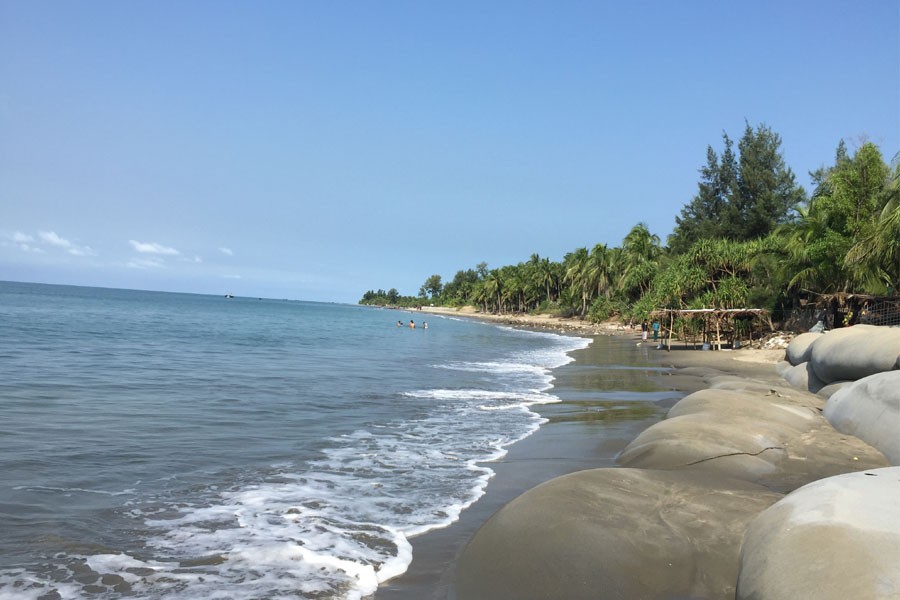Bangladesh’s Exclusive Economic Zone (EEZ) covers 118,813 km2 of the Bay of Bengal’s large marine ecosystem, located in the southeast corner of the country. With a 710 km coastline and three major coastal zones, Bangladesh possesses a unique coastal and marine habitat. This marine ecosystem is rich in biodiversity that encompasses a large number of fish, mollusk, mangrove, coral, plankton, seagrass and seaweed species.
However, the ecosystem and biodiversity are under threat due to anthropogenic pressure, overexploitation, environmental change, and lack of awareness. Because of this, conservation initiatives are urgently needed for Bangladesh. Most initiatives for marine ecosystem conservation in Bangladesh focus mainly on fisheries management, specifically temporary bans as well as gear and size restrictions. However, to conserve the overall biodiversity of the marine ecosystem, a holistic approach is required.
Declaration of a Marine Protected Area (MPA) is one of the modern concepts to conserve natural biodiversity. MPAs are dedicated spaces in the ocean for protecting and maintaining biological diversity as well as associated cultural resources.
Taking this into account, the government of Bangladesh has already declared two MPAs. In 2014, Swatch of No Ground was declared as the country’s first MPA, covering an area of 1,738 km2. In 2019, the government declared another 3,188 km2 around the Nijuhm Dwip Island as the second MPA/marine reserve, which increased the country’s MPA coverage to 2.8 per cent of its EEZ.
Although a number of management options are available, most are focused on fisheries, such as fishing ban periods and restrictions on mesh size. Since this area is a hotspot for a wide range of species, from primary producers to top predators, a holistic approach is required to conserve biodiversity, so declaring a new MPA here would be a good option for conserving the rich biodiversity in this area.
Taking the above into account, Funded by USAID Bangladesh, WorldFish’s Enhanced Coastal Fisheries in Bangladesh II (ECOFISH II) Activity, in collaboration with Shahjalal University of Science and Technology (SUST), conducted a thorough study from January 2020 to June 2021 to evaluate the potential of declaring the Teknaf–St Martin’s peninsula an MPA.
During this study, data was collected on the environment, biodiversity, ecological habitats, fishing and fishers’ socioeconomic conditions.
Based on all the studies, community consultations and other relevant available socio-ecological information, the interdisciplinary team developed recommendations for establishing a new MPA in the waterscapes around the Teknaf–St. Martin’s Island peninsula covering an area of 2,845 km2. With Bangladesh’s aim to have 10 per cent of its EEZ declared as MPAs, this new MPA if declared would add another 2.4 per cent towards this overall target, reaching 6.5 per cent altogether.
Considering the responsible restrictions necessary for proper management and monitoring, the proposed MPA is divided into four zones with four levels of restrictions.
Zone 1 (41 km2) would be like a red zone, where no fishing or any activities destructive to the habitat would be allowed. In Zone 2 (886 km2), no fishing activities would be allowed, but sailing, mooring and diving activities would be permitted, subject to specific limitations. Zone 3 (1,341 km2) would generally be a buffer zone that lies between the exterior of the water area and the restricted protected zone, with recreational navigations, research and fishing activities being allowed. Zone 4 (577 km2) would be like a green zone, where low-impact tourism activities could be allowed as well as educational and research activities.
As such, the proposed MPA is an important timely initiative to sustainably manage the unique coral habitat and its rich biodiversity, especially the colourful reef fish as well as megafaunas, such as sharks, skates, rays, turtles and dolphins.
Through sustainable biodiversity conservation and management, fish production would increase and the socio-ecological resilience of fishers’ communities would improve. Taken together, these actions would protect and restore this unique coral habitat. Finally, by declaring this 2,845 km2 an MPA, the country would add another 2.4 per cent toward its target of having 10 per cent of its EEZ declared as MPAs.
For the successful implementation of the proposed MPA, it’s important to ensure stakeholder engagement, focusing on the Department of Fisheries, Ministry of Fisheries and Livestock; Ministry of Environment, Forest and Climate Change, law enforcement agencies, local administration, local leaders and fishers.
It is also important to the proposed MPA area for declaration under the Marine Fisheries Act 2020 (Clause 3) with emphasis on regulating the number of tourists and tourist activities, in such a way that ensures having no significant impacts on resources and habitats, stop the extraction of coral completely, and regulate and minimise seaweed collection.
A greater emphasis should be given to promote Alternate Income Generating Activities (AIGAs) for the fishing communities, dependent on these resources, through government supports and the introduction of Payment for Ecosystem Services.


